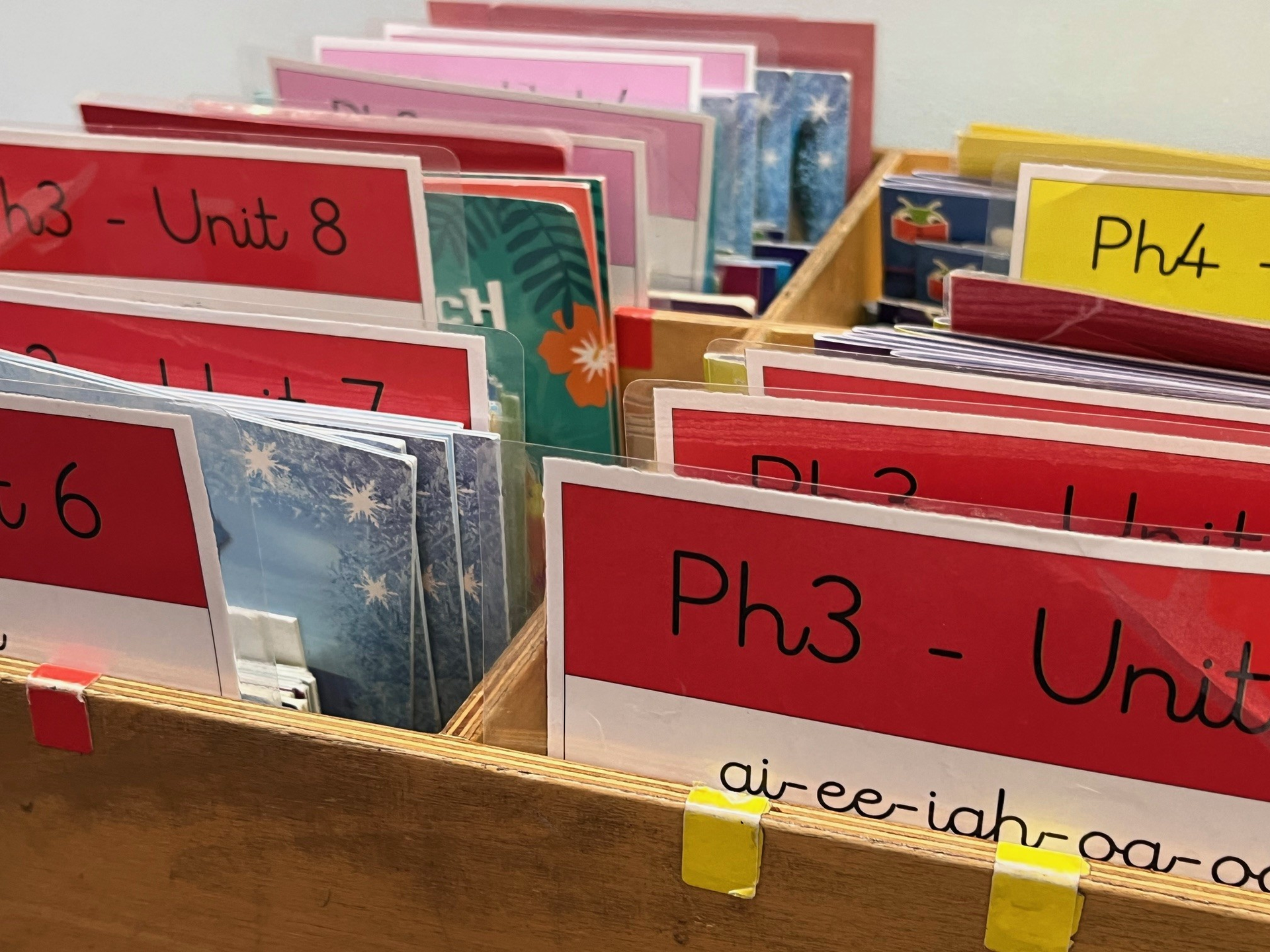
Phonics Vision
Through high-quality, systematic phonics teaching we aim for every child to become a confident and fluent reader. We want all children to develop a love of reading by finding the joy and excitement that stories, words, and language can bring them.
How we learn phonics
In school we follow the Bug Club Phonics Programme when teaching phonics. Phonics is all about sounds. There are 44 sounds in the English language, which we put together to form words. Some are represented by one letter, like ‘t’, and some by two or more, like ‘ck’ in duck and ‘air’ in chair.
Children are taught the sounds first, then how to match them to letters, and finally how to use the letter sounds for reading and spelling.
Synthetic phonics refers to ‘synthesising’, or blending, the sounds to read words. It is based on the idea that children should sound out unknown words and not rely on their context.
The reading books your child brings home are designed to support them in practising and consolidating the learning they have done at school. They also enable children to experience the pleasure and pride of reading their own books.
We teach phonics daily in EYFS, year 1 and year 2. When the children start school in EYFS we start off by teaching short bursts of phonics throughout the day, this is built up quickly so our phonics sessions last 30 minutes in total.
The children are assessed in phonics once a half term and from this assessment appropriate interventions from the Bug Club Programme are put in place for the children who need it.
Children who move into year 3 needing extra phonics input have regular sessions with an adult in order to close gaps in their learning and develop their reading fluency.
What is taught when
Below is an overview of the Bug Club phonics programme from EYFS to year 2 so you know what your child is learning when.
|
EYFS |
||
|
Term |
Phonemes taught |
Irregular words taught |
|
Phase 2 |
s, a, t, p, i, n, m, d, g, o, c, k, ck, e, u, r |
to, the, no, go |
|
Autumn 2 Phase 2 |
h, b, f, ff, l, ll, ss |
I, into, her |
|
Spring 1 Phase 3 |
j, v, w, x, y, z, zz, qu |
me, be, he, my, by, she |
|
Spring 2 Phase 3 |
ch, sh, th, ng, ai, ee, igh, oa, oo |
they, we, are |
|
Summer 1 Phase 3 |
ar, or, ur, ow, oi, ear, air, ure, er |
you, all, was, give |
|
Summer 2 Phase 4 |
Phase 4 consolidates phases 2 and 3 and looks at how we can blend more efficiently by saying some single sounds together such as ‘lk’ in ‘milk’ and ‘mp’ in ‘jump’. |
said, have, like, so, do, some, come, were, there, little, one, when, out, what |
|
Term |
Phonemes taught |
Irregular words taught |
|
Autumn 1 Phases 3 and 4 |
Review- Phases 3 and 4 |
Review – to, the, no, go, I, into, her, me, be, he, my, by, she, they, we, are, you, all, was, give, said, have, like, so, do, some, come, were, there, little, one, when, out, what |
|
Autumn 2 Phase 5 |
wh ph ai (ay, a_e, eigh, ey, ei) ee (ea, e_e, ie, ey, y) igh |
oh, their, people, Mr, Mrs, Ms, looked, called, asked |
|
Spring 1 Phase 5 |
igh (ie, i_e, y, i) oa (ow, o_e, o, oe) oo long (ew, ue, u_e) oo short (u, oul) |
water, where, who, again, thought, through |
|
Spring 2 Phase 5 |
or (aw, au, al) ur (ir, er, ear) ow (ou) oi (oy) ear (eer) air (are, ear) |
work, laughed, because, Thursday, Saturday, thirteen, thirty, different, any, many |
|
Summer 1 Phase 5 |
c (k, ck, ch) s (c(e), c(i), c(y), sc, st(l), se) |
eyes, friends, two, once, great, clothes |
|
Summer 2 Phase 5 |
j (ge, gi, gy, dge) l (le) m (mb) n (kn, gn) r (wr) ch (tch) sh alternatives e (ea) zh (s) o (wa) u (o) |
It’s, I’m, I’ll, I’ve, don’t, can’t, didn’t, first, second, third |
|
Year 2 |
||
|
Term |
Phonemes taught |
Irregular words taught |
|
Autumn 1 Phase 5 |
Review - All phase 5 phonemes. |
Review - it’s, I’m, I’ll, I’ve, don’t, can’t, didn’t, first, second, third, eyes, friends, two, once, great, clothes, it’s, I’m, I’ll, I’ve, don’t, can’t, didn’t, first, second, third |
|
Autumn 2 Phase 6 |
Suffixes – -ing -ed Silent e plus -ing/-ed -s (as a plural) -es after ss and x -es after ch, she and tch
Prefixes- re- un- |
clearing, gleaming, rained, mailed, men, mice, feet, teeth, sheep, vowel, consonant, prefix, suffix, syllable |
|
Spring and summer terms
|
From this point on, the children’s knowledge of spelling rules and alternative phonemes continues to be consolidated through reviews phases 5 and 6. If a child did not achieve the expected standard in the year 1 phonics screening, they will continue to have daily phonics sessions so they can retake the phonics screening in the summer of year 2. |
|
Parent guide to phonics
Here is a short video from Bug Club explaining phonics and why it is an important part of your child’s learning.
https://youtu.be/44mZZQfgkjY The Bug Club parent guide to phonics.
Sound pronunciation videos
Below are some videos demonstrating how to pronounce the phonemes and also the actions we use alongside the sound to help children remember.
https://mediaplayer.pearsoncmg.com/assets/bcpafsp2 Video link to phase 2 phonemes and actions.
https://mediaplayer.pearsoncmg.com/assets/bcpafsp3 Video link for phase 3 phonemes and actions.
https://mediaplayer.pearsoncmg.com/assets/bcpafsp5a Video link for phase 5 units 13-21 phonemes and actions.
https://mediaplayer.pearsoncmg.com/assets/bcpafs5 Video link for phase 5 units 22-27 phonemes and actions.
Using Bug Club at home
Bug Club is also available to you at home. Children can access ebooks and phonics activities to enhance their learning and practice at home. A guide to the website for parents can be found here (add link). If you need a reminder of your child’s log in details please contact their class teacher.














